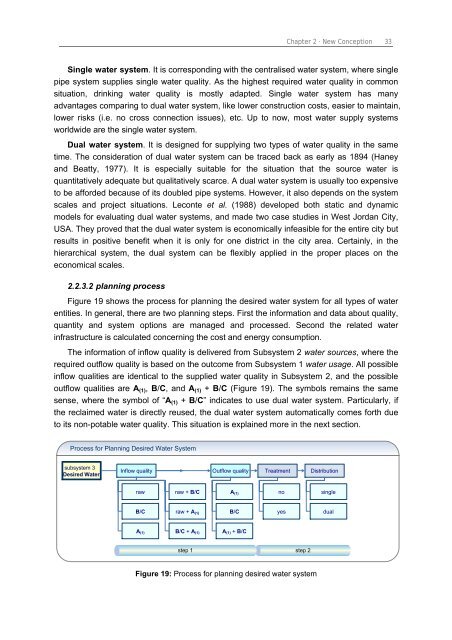Chapter 3 Decision Support Model (IUWS-DSM) - Tubdok
Chapter 3 Decision Support Model (IUWS-DSM) - Tubdok
Chapter 3 Decision Support Model (IUWS-DSM) - Tubdok
You also want an ePaper? Increase the reach of your titles
YUMPU automatically turns print PDFs into web optimized ePapers that Google loves.
<strong>Chapter</strong> 2 · New Conception 33<br />
Single water system. It is corresponding with the centralised water system, where single<br />
pipe system supplies single water quality. As the highest required water quality in common<br />
situation, drinking water quality is mostly adapted. Single water system has many<br />
advantages comparing to dual water system, like lower construction costs, easier to maintain,<br />
lower risks (i.e. no cross connection issues), etc. Up to now, most water supply systems<br />
worldwide are the single water system.<br />
Dual water system. It is designed for supplying two types of water quality in the same<br />
time. The consideration of dual water system can be traced back as early as 1894 (Haney<br />
and Beatty, 1977). It is especially suitable for the situation that the source water is<br />
quantitatively adequate but qualitatively scarce. A dual water system is usually too expensive<br />
to be afforded because of its doubled pipe systems. However, it also depends on the system<br />
scales and project situations. Leconte et al. (1988) developed both static and dynamic<br />
models for evaluating dual water systems, and made two case studies in West Jordan City,<br />
USA. They proved that the dual water system is economically infeasible for the entire city but<br />
results in positive benefit when it is only for one district in the city area. Certainly, in the<br />
hierarchical system, the dual system can be flexibly applied in the proper places on the<br />
economical scales.<br />
2.2.3.2 planning process<br />
Figure 19 shows the process for planning the desired water system for all types of water<br />
entities. In general, there are two planning steps. First the information and data about quality,<br />
quantity and system options are managed and processed. Second the related water<br />
infrastructure is calculated concerning the cost and energy consumption.<br />
The information of inflow quality is delivered from Subsystem 2 water sources, where the<br />
required outflow quality is based on the outcome from Subsystem 1 water usage. All possible<br />
inflow qualities are identical to the supplied water quality in Subsystem 2, and the possible<br />
outflow qualities are A(1), B/C, and A(1) + B/C (Figure 19). The symbols remains the same<br />
sense, where the symbol of “A(1) + B/C” indicates to use dual water system. Particularly, if<br />
the reclaimed water is directly reused, the dual water system automatically comes forth due<br />
to its non-potable water quality. This situation is explained more in the next section.<br />
Process for Planning Desired Water System<br />
subsystem 3<br />
Desired Water<br />
Inflow quality<br />
raw<br />
B/C<br />
A(1)<br />
raw + B/C<br />
raw + A(1)<br />
B/C + A(1)<br />
step 1<br />
Outflow quality<br />
A(1)<br />
B/C<br />
A(1) + B/C<br />
Treatment<br />
no<br />
yes<br />
step 2<br />
Figure 19: Process for planning desired water system<br />
Distribution<br />
single<br />
dual

















